The 1st Annual Cannabis Quality Conference & Expo featured dynamic discussions both in the sessions as well as on the exhibit floor. Take a look at some of the highlights from this year’s conference and expo.
All image credit: amyBcreative

The 1st Annual Cannabis Quality Conference & Expo featured dynamic discussions both in the sessions as well as on the exhibit floor. Take a look at some of the highlights from this year’s conference and expo.
All image credit: amyBcreative
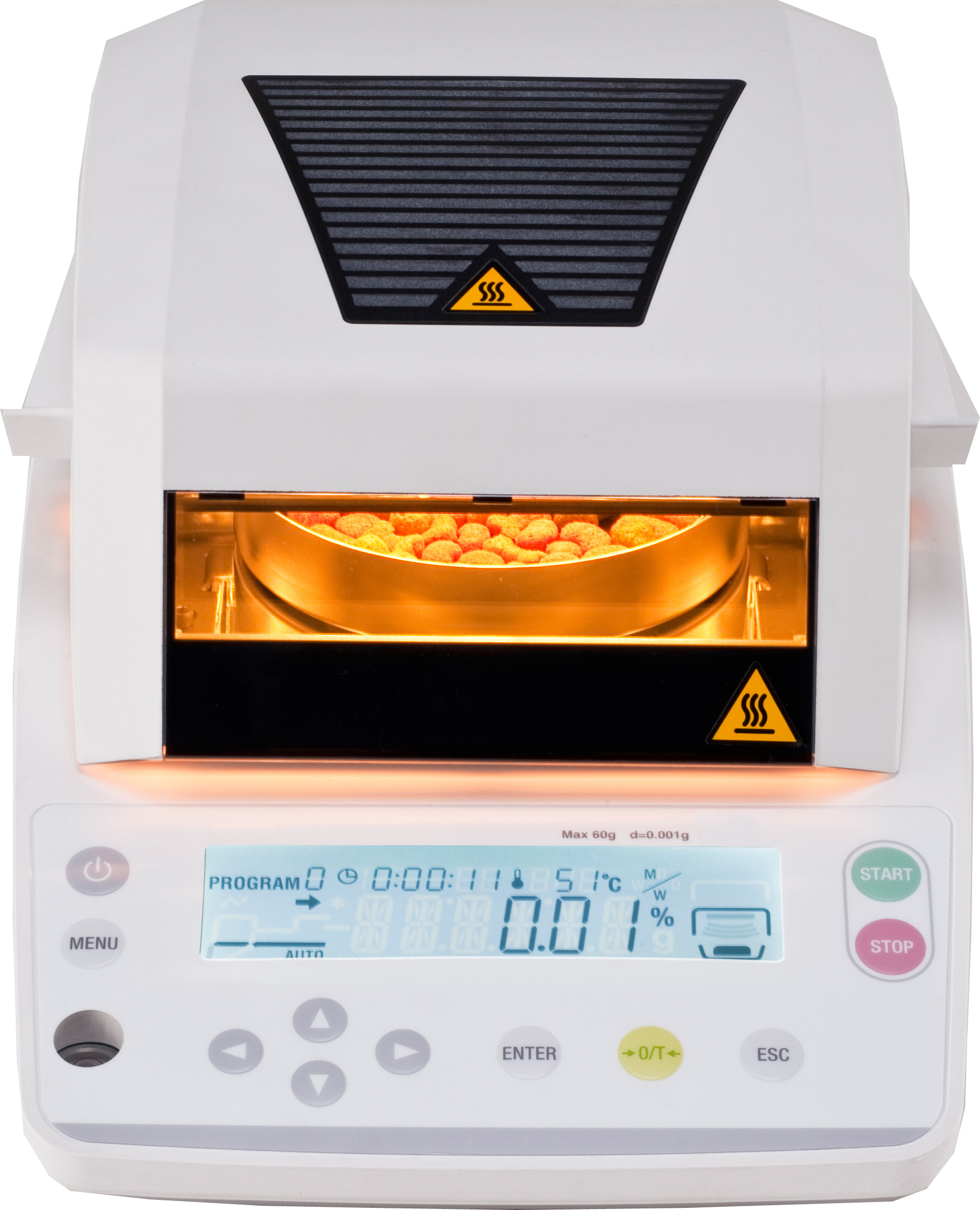
The cannabis industry is growing exponentially, and the use of cannabis for medical purposes is being adopted across the nation. With this boom in cannabis consumers, there has been an increasing need for knowledge about the product.
The role of testing labs has become crucial to the process, which makes owning and operating a lab more lucrative. Scientists testing for potency, heavy metals, pesticides, residual solvents, moisture, terpene profile, microbial and fungal growth, and mycotoxins/aflatoxins are able to make meaningful contributions to the medical industry by making sure products are safe, while simultaneously generating profits and a return on investment.
Here are the key testing instruments you need to conduct these critical analyses. Note that cannabis analytical testing requirements may vary by state, so be sure to check the regulations applicable to the location of your laboratory.

The most important component of cannabis testing is the analysis of cannabinoid profiles, also known as potency. Cannabis plants naturally produce cannabinoids that determine the overall effect and strength of the cultivar, which is also referred to as the strain. There are many different cannabinoids that all have distinct medicinal effects. However, most states only require testing and reporting for the dry weight percentages of delta-9-tetrahydrocannabinol (Δ9-THC) and cannabidiol (CBD). It should be noted that delta-9-tetrahydrocannabinolic acid (Δ9-THCA) can be converted to THC through oxidation with heat or light.
For potency testing, traditional high-performance liquid chromatography (HPLC) is recommended and has become the gold standard for analyzing cannabinoid profiles. Look for a turnkey HPLC analyzer that delivers a comprehensive package that integrates instrument hardware, software, consumables and proven HPLC methods.

Different types of metals can be found in soils and fertilizers, and as cannabis plants grow, they tend to draw in these metals from the soil. Heavy metals are a group of metals considered to be toxic, and the most common include lead, cadmium, arsenic and mercury. Most labs are required to test and confirm that samples are under the allowable toxic concentration limits for these four hazardous metals.
Heavy metal testing is performed by inductively coupled plasma mass spectrometry (ICP-MS). ICP-MS uses the different masses of each element to determine which elements are present within a sample and at what concentrations. Make sure to include accompanying software that provides assistant functions to simplify analysis by developing analytical methods and automatically diagnosing spectral interference. This will provide easy operation and analytical results with exceptionally high reliability.
To reduce running costs, look for a supporting hardware system that reduces the consumption of argon gas and electricity. For example, use a plasma ignition sequence that is optimized for lower-purity argon gas (i.e., 99.9% argon as opposed to more expensive 99.9999%).
The detection of pesticides in cannabis can be a challenge. There are many pesticides that are used in commercial cannabis grow operations to kill the pests that thrive on the plants and in greenhouses. These chemicals are toxic to humans, so confirming their absence from cannabis products is crucial. The number of pesticides that must be tested for varies from state to state, with Colorado requiring only 13 pesticides, whereas Oregon and California require 59 and 66 respectively. Canada has taken it a step further and must test for 96 pesticides, while AOAC International is developing methods for testing for 104 pesticides. The list of pesticides will continue to evolve as the industry evolves.
Testing for pesticides is one of the more problematic analyses, possibly resulting in the need for two different instruments depending on the state’s requirements. For a majority of pesticides, liquid chromatography mass spectrometry (LCMS) is acceptable and operates much like HPLC but utilizes a different detector and sample preparation.

Pesticides that do not ionize well in an LCMS source require the use of a gas chromatography mass spectrometry (GCMS) instrument. The principles of HPLC still apply – you inject a sample, separate it on a column and detect with a detector. However, in this case, a gas (typically helium) is used to carry the sample.
Look for a LC-MS/MS system or HPLC system with a triple quadrupole mass spectrometer that provides ultra-low detection limits, high sensitivity and efficient throughput. Advanced systems can analyze more than 200 pesticides in 12 minutes.
For GCMS analysis, consider an instrument that utilizes a triple quadrupole mass spectrometer to help maximize the capabilities of your laboratory. Select an instrument that is designed with enhanced functionality, analysis software, databases and a sample introduction system. Also include a headspace autosampler, which can also be used for terpene profiles and residual solvent testing.
Residual solvents are chemicals left over from the process of extracting cannabinoids and terpenes from the cannabis plant. Common solvents for such extractions include ethanol, butane, propane and hexane. These solvents are evaporated to prepare high-concentration oils and waxes. However, it is sometimes necessary to use large quantities of solvent in order to increase extraction efficiency and to achieve higher levels of purity. Since these solvents are not safe for human consumption, most states require labs to verify that all traces of the substances have been removed.
Testing for residual solvents requires gas chromatography (GC). For this process, a small amount of extract is put into a vial and heated to mimic the natural evaporation process. The amount of solvent that is evaporated from the sample and into the air is referred to as the “headspace.” The headspace is then extracted with a syringe and placed in the injection port of the GC. This technique is called full-evaporated technique (FET) and utilizes the headspace autosampler for the GC.
Look for a GCMS instrument with a headspace autosampler, which can also be used for pesticide and terpene analysis.
Terpenes are produced in the trichomes of the cannabis leaves, where THC is created, and are common constituents of the plant’s distinctive flavor and aroma. Terpenes also act as essential medicinal hydrocarbon building blocks, influencing the overall homeopathic and therapeutic effect of the product. The characterization of terpenes and their synergistic effect with cannabinoids are key for identifying the correct cannabis treatment plan for patients with pain, anxiety, epilepsy, depression, cancer and other illnesses. This test is not required by most states, but it is recommended.
The instrumentation that is used for analyzing terpene profiles is a GCMS with headspace autosampler with an appropriate spectral library. Since residual solvent testing is an analysis required by most states, all of the instrumentation required for terpene profiling will already be in your lab.
As with residual solvent testing, look for a GCMS instrument with a headspace autosampler (see above).
Most states mandate that cannabis testing labs analyze samples for any fungal or microbial growth resulting from production or handling, as well as for mycotoxins, which are toxins produced by fungi. With the potential to become lethal, continuous exposure to mycotoxins can lead to a buildup of progressively worse allergic reactions.
LCMS should be used to qualify and identify strains of mycotoxins. However, determining the amount of microorganisms present is another challenge. That testing can be done using enzyme linked immunosorbent assay (ELISA), quantitative polymerase chain reaction (qPCR) or matrix-assisted laser desorption/ionization time-of-flight mass spectrometry (MALDI-TOF MS), with each having their advantages and disadvantages.
For mycotoxin analysis, select a high-sensitivity LC-MS/MS instrument. In addition to standard LC, using an MS/MS selective detector enables labs to obtain limits of detection up to 1000 times greater than conventional LC-UV instruments.
For qPCR and its associated needs, look for a real-time PCR amplification system that combines thermal cyclers with optical reaction modules for singleplex and multiplex detection of fluorophores. These real-time PCR detection systems range from economical two-target detection to sophisticated five-target or more detection systems. The real-time detection platform should offer reliable gradient-enabled thermal cyclers for rapid assay optimization. Accompanying software built to work with the system simplifies plate setup, data collection, data analysis and data visualization of real-time PCR results.
Moisture content testing is required in some states. Moisture can be extremely detrimental to the quality of stored cannabis products. Dried cannabis typically has a moisture content of 5% to 12%. A moisture content above 12% in dried cannabis is prone to fungal growth (mold). As medical users may be immune deficient and vulnerable to the effects of mold, constant monitoring of moisture is needed. Below a 5% moisture content, the cannabis will turn to a dust-like texture.
The best way to analyze the moisture content of any product is using the thermogravimetric method with a moisture balance instrument. This process involves placing the sample of cannabis into the sample chamber and taking an initial reading. Then the moisture balance instrument heats up until all the moisture has been evaporated out of the sample. A final reading is then taken to determine the percent weight of moisture that was contained in the original sample.

Look for a moisture balance that offers intuitive operation and quick, accurate determination of moisture content. The pan should be spacious enough to allow large samples to be spread thinly. The halogen heater and reflector plate should combine to enable precise, uniform heating. Advanced features can include preset, modifiable measurement modes like automated ending, timed ending, rapid drying, slow drying and step drying.
Another method for preventing mold is monitoring water activity (aW). Very simply, moisture content is the total amount of water available, while water activity is the “free water” that could produce mold. Water activityranges from 0 to 1. Pure water would have an aW of 1.0. ASTM methods D8196-18 and D8297-18 are methods for monitoring water activity in dry cannabis flower. The aW range recommended for storage is 0.55 to 0.65. Some states recommend moisture content to be monitored, other states monitor water activity, and some states such as California recommend monitoring both.
As you can see, cannabis growers benefit tremendously from cannabis testing. Whether meeting state requirements or certifying a product, laboratory testing reduces growers’ risk and ensures delivery of a quality product. As medicinal and recreational cannabis markets continue to grow, analytical testing will ensure that consumers are receiving accurately
labeled products that are free from contamination. That’s why it is important to invest in the future of your cannabis testing lab by selecting the right analytical equipment at the start of your venture.
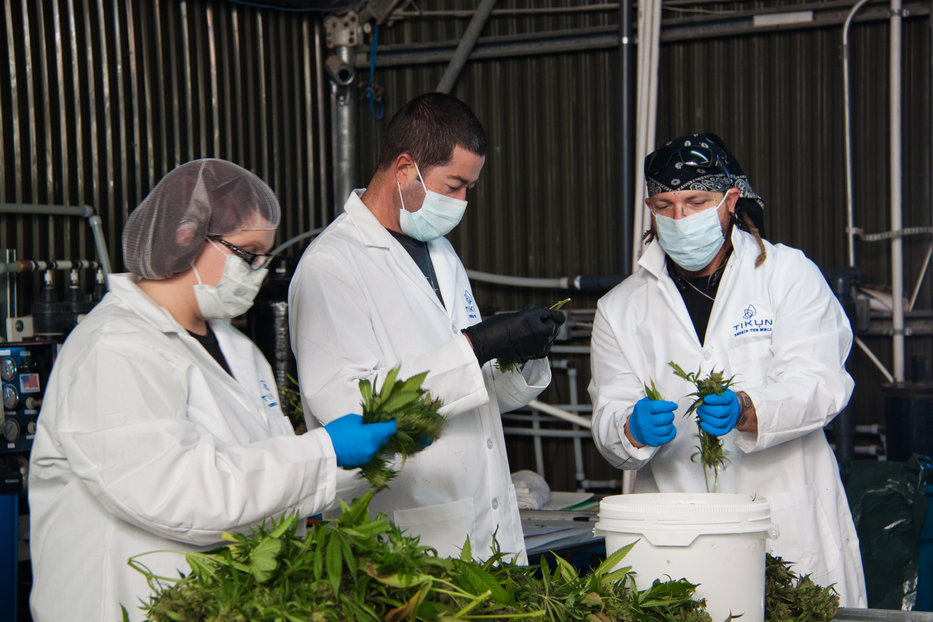
Mold is ubiquitous in nature and can be found everywhere.1 Cannabis growers know this all too well – the cannabis plant, by nature, is an extremely mold-susceptible crop, and growers battle it constantly.
Of course, managing mold doesn’t mean eradicating mold entirely – that’s impossible. Instead, cultivation professionals must work to minimize the amount of mold to the point where plants can thrive, and finished products are safe for consumption.
Let’s begin with that end in mind – a healthy plant, grown, cured and packaged for sale. In a growing number of states, there’s a hurdle to clear before the product can be sold to consumers – state-mandated testing.
So how do you ensure that the product clears the testing process within guidelines for mold? And what tools can be employed in biological warfare?
It helps to first understand how the cannabis plant becomes an optimal environment.
The cannabis flower was designed to capture pollen floating in the air or brought by a pollinating insect.

Once a mold spore has landed in a flower, the spore will begin to grow. The flower will continue to grow as well, and eventually, encapsulate the mold. Once the mold is growing in the middle of the flower, there is no way to get rid of it without damaging the flower.
The types of spores found in or around a plant can make or break whether mold will end with bad product.
Aspergillus for example, is a mold that can produce mycotoxins, which are toxic to humans2. For this reason, California has mandatory testing3for certain aspergillus molds.
Another example, Basidiospores, are found outside, in the air. These are spores released from mushrooms and have no adverse effects on cannabis or a cannabis cultivation facility.
Fungi like powdery mildew and botrytis (PM and Bud Rot) typically release spores in the air before they are physically noticed on plants. Mold spores like these can survive from one harvest to the next – they can be suspended in the air for hours and be viable for years.
Different types of spores – the reproductive parts of mold – get released from different types of mold. Similar to plants and animals, mold reproduces when resources are deemed sufficient.
The opposite is also true that if the mold is under enough stress, such as a depleting nutrient source, it can be forced into reproduction to save itself.4
In the end, mold spores are released naturally into the air for many reasons, including physical manipulation of a plant, which, of course, is an unavoidable task in a cultivation facility.5
Because of the almost-constant physical manipulation of plants that happen inside its walls, a grow’s trimming areas typically have the highest spore counts. Even the cleanest of plants will release spores during trimming.
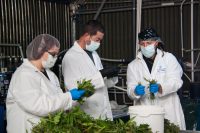
These rooms also have the highest risk for cross contamination, since frequently, growers dry flower in the same room as they trim. Plus, because trimming can be labor intensive, with a large number of people entering and leaving the space regularly, spores are brought in and pushed out and into another space.
The prevalence and ubiquitous nature of mold in a cannabis facility means that the fight against it must be smart, and it must be thorough.
By incorporating an upstream approach to facility biosecurity, cultivators can protect themselves against testing failures and profit losses.
Biosecurity must be all encompassing, including everything from standard operating procedures and proper environmental controls, to fresh air exchange and surface sanitation/disinfection.
One of the most effective tactics in an upstream biosecurity effort is fungal monitoring.
Determining the load or amount of mold that is in a facility is and always will be common practice. This occurs in a few ways.
Post-harvest testing is in place to ensure the safety of consumers, but during the growing process, is typically done using “scouting reports.” A scouting report is a human report: when personnel physically inspect all or a portion of the crop. A human report, unfortunately, can lead to human error, and this often doesn’t give a robust view of the facility mold picture.
Another tool is agar plates. These petri dishes can be opened and set in areas suspected to have mold. Air moves past the plate and the mold spores that are viable land on the dishes. However, this process is time intensive, and still doesn’t give a complete picture.
Alternatively, growers can use spore traps to monitor for mold.
Spore traps draw a known volume of air through a cassette.6 The inside of the cassette is designed to force the air toward a sticky surface, which is capable of capturing spores and other materials. The cassette is sent to a laboratory for analysis, where they will physically count and identify what was captured using a microscope.
Spore trap results can show the entire picture of a facility’s mold concerns. This tool is also fast, able to be read on your own or sent to a third party for quick and unbiased review. The information yielded is a useful indicator for mold load and which types are prevalent in the facility.
What’s going on inside of a facility has a direct correlation to what’s happening outside, since facility air comes infromthe outside. Thus, spore traps are most effective when you compare a trap inside with one set outside.
When comparing the two, you can see what the plants are doing, view propagating mold, and understand which of the spore types are only found inside.
Similar to its use in homes and businesses for human health purposes, monitoring can indicate the location of mold growth in a particular area within a facility.
These counts can be used to determine the efficacy of cleaning and disinfecting a space, or to find water leaks or areas that are consistently wet (mold will grow quickly and produce spores in these areas).
Utilizing spore traps for regular, facility-wide mold monitoring is advantageous for many reasons.
One example: Traps can help determine critical control points (CCP) for mold.
 What does this look like? If the spore count is two times higher than usual, mitigating action needs to take place. Integrated Pest Management (IPM) strategies like cleaning and disinfecting the space, or spraying a fungicide, are needed to bring the spore count down to its baseline.
What does this look like? If the spore count is two times higher than usual, mitigating action needs to take place. Integrated Pest Management (IPM) strategies like cleaning and disinfecting the space, or spraying a fungicide, are needed to bring the spore count down to its baseline.
For example, most facilities will see a spike in spore counts during the times of initial flower production/formation (weeks two to three of the flower cycle).
Seasonal trends can be determined, as well, since summer heat and rain will increase the mold load while winter cold may minimize it.
Fungal monitoring – especially using a spore trap – is a critical upstream step in a successful IPM strategy. But it’s not the only step. In fact, there are five:
Each step must be followed to succeed in the battle against mold.
Of course, in the battle, there may be losses. If you experience a failed mandatory product testing result, use the data from the failure to fix your facility and improve for the future.
The data can be used to determine efficacy of standard operating procedures, action thresholds, and other appropriate actions. Plus, you can add a spore trap analysis for pre- and post- disinfection protocols, showing whether the space was really cleaned and disinfected after application. This will also tell you whether your products are working.
Leveraging all of the tools available will ensure a safe, clean cannabis product for consumers.
References

On July 18, 2019, the Riverside County Sheriff’s Department in California served search warrants at 56 illegal cannabis cultivation sites. This operation was spearheaded by 390 law enforcement personnel, whose mission was to combat the ongoing problem of illegal cannabis cultivation sites throughout California.
The target of the operation was illegal cultivation sites. Individuals or licensed businesses with permits to grow cannabis legally were not affected.
Illegal cultivation is far from just a California problem. For example, if Oregon halted cannabis production today, the state would not experience a shortage as it has a six-year surplus.
The fear for investors and legal growers is that, if some growers turn to the black market to unload excess inventory, federal enforcement will come into play, which will set back the legal cannabis industry to the stone age. Oregon is currently making moves to limit licensure for legal production, but some active licenses may also need to be revoked, which would leave those licensees with vast investment losses. In other words, legalized cannabis’s massive economic market is not without financial problems of its own.
 Several states have legalized recreational cannabis with the intention of reimagining this vast underground market as an above-board business that bolsters the state’s economy via transparent dealings. To date, however, the federal government has refused to budge regarding cannabis’s status as an illegal Schedule 1 substance. This classification puts cannabis on a par with opioids. As such, those states that have legalized recreational cannabis are extremely motivated to keep these businesses on the up and up and not to pique federal interest.
Several states have legalized recreational cannabis with the intention of reimagining this vast underground market as an above-board business that bolsters the state’s economy via transparent dealings. To date, however, the federal government has refused to budge regarding cannabis’s status as an illegal Schedule 1 substance. This classification puts cannabis on a par with opioids. As such, those states that have legalized recreational cannabis are extremely motivated to keep these businesses on the up and up and not to pique federal interest.
One of the tenets of legalizing cannabis is stemming the proliferation of black-market suppliers and minimizing the negative effects that the “war on drugs”has had in minority communities. These positive impetuses have yet to flourish. As a result of the illegal status of cannabis at the federal level, cannabis-legal states are forced to operate as islands.
Generally, taking legally purchased cannabis across state lines – from a legal to an illegal state – is illegal, and this is not only confusing but is also a recipe for complications. This leaves cannabis-legal states vulnerable to black market activity. These pockets of legal recreational cannabis that are popping up around the country loosen the constraints of the cannabis movement while the legality of this movement remains problematic. The results are an environment that’s extremely hospitable to black market activity.
The reality is that – due to supply and demand – cannabis costs about half as much in cannabis-legal states as it does in states in which it’s illegal. Black market growers in legal states destabilize the market. Those legit companies which remain above board, pay their taxes and jump through every legal hoop, cannot compete with black market interlopers who eschew such niceties.
The point made by detractors of legal cannabis isn’t lost on the rest of us – the black market is burgeoning.States that have legalized production have inadvertently made it easier for illegal producers to hide in plain sight, and the line between legal and illegal operations can become blurred. This creates new frustrations for law enforcement and naturally cuts into the legal cannabis trade. The situation has left some opponents to legalization demanding new crackdowns – others characterize such suggestions as amounting to a new war on drugs.
Detractors of legalized cannabis claim the somewhat chaotic effects related to the current patchwork approach to legalization are a result of opening the gates to legalization in the first place. However, putting the genie of legalized recreational cannabis back in the bottle simply isn’t feasible for operational, financial and political reasons. With the proliferation of attendant illegal operations, however, it is becoming more and more clear that leveling the playing field – via some form of federal legalization – is inevitable. The current state-by-state solution leaves too much wiggle room for the illegal transport of cannabis from those states with looser restrictions to those states with tighter protocols. If politics is choosing between the disastrous and the unpalatable, the billion-dollar cannabis conundrum is a great example. The question may no longer be should we legalize cannabis but, instead, how do we legalize cannabis.In other words, we need to find a path forward, and focusing only on the pitfalls that we’ve experienced so far isn’t going to get us where we need to be.
The point made by detractors of legal cannabis isn’t lost on the rest of us – the black market is burgeoning. As such, we have an important decision to make. A blanket prohibition of cannabis may no longer be practicable, so we’re left to choose between legal and overt practices across the board or a hodgepodge of semilegal practices with covert ops in tow. Fostering illegal activity is rarely in our nation’s best interests, which leaves legalizing cannabis at the federal level as possibly the most practicable solution.
 As more states embrace the legalization of recreational cannabis, public health concerns remain an issue. Many of these illegal cultivators use chemicals that are banned in the United States and do not properly dispose of chemicals or waste products that destroy the environment, contaminate drinking water and have the potential to harm or even kill residents and domestic animals. Not only is this activity harmful, growers often steal electricity and water from surrounding residents.
As more states embrace the legalization of recreational cannabis, public health concerns remain an issue. Many of these illegal cultivators use chemicals that are banned in the United States and do not properly dispose of chemicals or waste products that destroy the environment, contaminate drinking water and have the potential to harm or even kill residents and domestic animals. Not only is this activity harmful, growers often steal electricity and water from surrounding residents.
Cobbling together a pastiche of laws, however, inevitably bolsters black market activity and does nothing to help protect public health. Even the staunchest proponents of legalizing cannabis don’t want minors involved in the equation. Additionally, few debate that unchecked usage is a healthy option. Quasi-legislation at the state level (and on a state-by-state basis), however, provides neither a check nor a balance.
The most likely next step for safeguarding public health, for stemming black-market activity, and for generating maximum revenues is toward thoughtful and comprehensive national legalization that comes sooner rather than later. In the meantime, law enforcement should protect the public, legal operations, investors, and the environment from the black market.
The opinions expressed are those of the author and do not necessarily reflect the views of Guidepost Solutions or its clients.

I had dinner last night with a friend who is a senior executive at one of the largest automobile companies in the world. When I explained the industry-accepted rate of 25-30% shrinkage in horticulture he said, “Are you kidding me? Can you imagine the story in the Wall Street Journal if I gave a press conference and said that we were quite content to throw away three out of every ten cars we manufactured?”
Yet, for all growers, operators and investors who complain about shrinkage, it’s an accepted part of the business. What if it wasn’t; what if you could shrink your shrinkage by 60% and get it down to 10% or less? How much more profitable would your business be and how much easier would your life be?
Let’s take the floriculture industry as our first example. You propagate chrysanthemums in February, they get repotted at the end of April and by the end of June, you might start to see some buds. In a very short time span your job changes from being a grower who manages 10,000 square feet of chrysanthemums to being an order taker. Over a period of eight weeks, you have to unload as many of those mums as possible. The sales team at Macy’s has more time to move their holiday merchandise than you do.
If you’re like most operations, your inventory tracking system consists of Excel spreadsheets and notebooks that tell you what happened in previous years so you can accurately predict what will happen this year. The notebooks give you a pretty accurate idea of where in the greenhouses your six cultivars are, how many you planted and which of the five stages they are in. You already have 30 different sets of data to manage before you add on how many you sell of each cultivar and what stage they were in.
The future of the industry is making data-driven decisions that free up a grower to focus on solving problems, not looking for problems.Then your first order comes in and out the window goes any firm control of where the mums are, what stage they’re in and how many of each cultivar you have left. A couple of hours after your first order, a second comes in and by the time you get back in touch, check your inventory, call back the buyer and she’s able to connect with you, those 2837 stage 3 orange mums are moving into stage 4. Only she doesn’t want stage 4 mums she only wants stage 3 so now you frantically call around to see who wants stage 4 orange mums very soon to be stage 5 mums.
And, the answer is often no one. What if you didn’t have your inventory count exact and now you have 242 yellow mums that you just found in a different location in your greenhouse and had you known they were there, you could have sold them along with 2463 other mums that you just located in various parts of your greenhouse.
It doesn’t have to be like that. We had a client in a similar situation, and they are on track to reduce their shrinkage to just a shade over 10%. The future of the industry is making data-driven decisions that free up a grower to focus on solving problems, not looking for problems.
And don’t think that shrinkage is an issue only in the purview of floriculture. It’s an even bigger problem for cannabis because of the high value of each crop. The numbers don’t sound as bad because unlike floriculture, you don’t have to throw out cannabis that’s not Grade A. You can always sell it for extract. But extract prices are significantly less per pound than flower in the bag.
Here’s how one grower explained it. “Because of the high value of the crop, and the only other crop I’ve worked with that high is truffles, you’re playing a much higher stakes game with shrinkage. Even if you try and salvage a bad crop by using all of the parts of the cannabis plant. Listen, the difference between Grade A and Grade C could be $1,000 for A while a pound of B/C is less than $400. If you produce a standard 180 to 200 pounds in your grow rooms, you’ve really screwed up. No operator is going to keep you if you just cost them $120,000.”

Basic business liability coverage is not enough for those cultivating, selling and distributing cannabis. General liability, property and even commercial renter’s insurance policies all exclude aspects of cannabis operations, leading to significant gaps in coverage.
Unfortunately, many cannabis operations purchase traditional property policies, assuming they’re insured. Then, when a claim comes to light, they find out they’re not covered.Consider the following common exclusions that could lead to a costly business interruption – or worse
Although the production, sales and distribution of cannabis is legal in many U.S. states, it is still illegal federally. This disparity can cause confusion when it comes to insurance compliance. Cannabis companies will want to secure industry specific coverage for risks associated with property, business interruption, and auto as well as general liability.
Consider the following common exclusions that could lead to a costly business interruption – or worse – a shutdown of operations when not properly insured:
Organizations looking for cannabis business insurance are best off working with a qualified broker who is knowledgeable in the cannabis space.As the cannabis industry continues to expand, more and more insurance options have become available. And yet as with any fast-paced industry, not every option that appears legitimate is a good risk for your cannabis business.
Be a contentious insurance consumer. Review the policy closely for exclusions and coverage features so you understand the premium rates and limits of the policy. Discuss with your broker the history of the carrier as to paying claims in a timely fashion.
Organizations looking for cannabis business insurance are best off working with a qualified broker who is knowledgeable in the cannabis space.
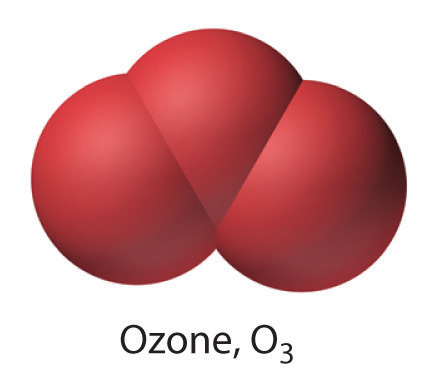
California was the first state to step up to defend consumers from false marketing claims that ozone generators are safe, effective air purifiers. In reality, ozone is a lung irritant, especially harmful to allergy and asthma sufferers. In 2009, California became the first state in the nation to ban ozone generators. The Air Resources Board of the California Environmental Protection Agency states:
Not all air-cleaning devices are appropriate for use — some can be harmful to human health. The ARB recommends that ozone generators, air cleaners that intentionally produce ozone, not be used in the home or anywhere else humans are present. Ozone is a gas that can cause health problems, including respiratory tract irritation and breathing difficulty.
 The regulation took effect in 2009 along with a ban on the sale of air purifiers that emit more than 0.05 parts per million of ozone. The ARB says that anything beyond this is enough to harm human health; however, some experts say that there is no safe level of ozone.
The regulation took effect in 2009 along with a ban on the sale of air purifiers that emit more than 0.05 parts per million of ozone. The ARB says that anything beyond this is enough to harm human health; however, some experts say that there is no safe level of ozone.
The National Institute for Occupational Safety and Health recommends an exposure limit to ozone of 0.1 ppm and considers levels of 5 ppm or higher “immediately dangerous to life or health.”
If you’re shopping for an air purifier, it’s best to avoid ozone generators, especially if you have a respiratory condition. Ozone generators, and ionic air cleaners that emit ozone, can cause asthma attacks in humans while doing little to nothing to clean the air.
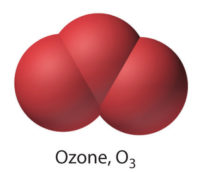 O3 is a free radical, an oxidizer; when it meets any organic molecule floating around it bonds to it and destroys it. In a grow room, organic molecules include the essential oils in cannabis which produce the fragrance. When using ozone within your grow room, too much will not only all but eliminate the smell of your flowers but with prolonged exposure, it begins to actually degrade the cell walls of trichomes and destroy the structure of the glands.
O3 is a free radical, an oxidizer; when it meets any organic molecule floating around it bonds to it and destroys it. In a grow room, organic molecules include the essential oils in cannabis which produce the fragrance. When using ozone within your grow room, too much will not only all but eliminate the smell of your flowers but with prolonged exposure, it begins to actually degrade the cell walls of trichomes and destroy the structure of the glands.
Despite the claims of some manufacturers, ozone does not have an anti-microbial effect in air unless levels far exceed the maximums of the regulation and is therefore harmful humans.
Keeping the grow room clean of mold and bacteria is important, but ozone is not the technology you want to employ to satisfy this goal. Looking into a combination of UVC and Filtration will better meet the goal while keeping both your plants and staff healthy.

While cannabis patenting activity is still in its infancy, relatively speaking, a lot has been written already about the cannabis patenting activity of an entity called Biotech Institute LLC (BI) of Westlake Village, California.1 BI is building a sizable portfolio of utility and plant patents covering various aspects of the cannabis plant. According to some commentators, BI’s patents have “many in the cannabis industry concerned.”2
But how concerned should members of the cannabis industry really be about BI’s patents? Generally, patents are susceptible to numerous challenges in multiple fora. From 2012-2016, approximately 80% of challenged patents were invalidated by the Patent Trial and Appeal Board (PTAB) each year.3 The PTAB was created in 2011 by the Leahy-Smith America Invents Act, 35 U.S.C. § 6, to create a process for eliminating improvidently issued patents. And the statistics suggest that the process may be working as intended by Congress.
BI may be building its portfolio by taking advantage of some unique challenges in the cannabis patenting area. First, even though cannabis has been cultivated and consumed by humans for thousands of years, there is a relative lack of published prior art available to patentees and patent examiners examining patent applications.4 Second, patent examiners are not as familiar with cannabis patent applications as they may be with other types of patent applications.
 So, we examined carefully BI’s earliest and arguably broadest utility patent, U.S. Patent No. 9,095,554, and concluded that maybe the cannabis industry need not be so concerned about this and some of BI’s other utility patents. Although the ’554 patent is lengthy – 247 columns of text and over an inch thick when printed in hardcopy – there appears to be little if any novelty to the claimed invention. Alternatively, the patent appears to be obvious in light of the available prior art.
So, we examined carefully BI’s earliest and arguably broadest utility patent, U.S. Patent No. 9,095,554, and concluded that maybe the cannabis industry need not be so concerned about this and some of BI’s other utility patents. Although the ’554 patent is lengthy – 247 columns of text and over an inch thick when printed in hardcopy – there appears to be little if any novelty to the claimed invention. Alternatively, the patent appears to be obvious in light of the available prior art.
In a patent, the claims define the metes and bounds of the patentee’s intellectual property. Claim 1 of the ’554 patent recites:
While claim elements define the metes and bounds of the invention, typically only certain claim elements are intended to distinguish the claimed invention from the prior art. Other claim elements merely help to describe the invention. For example, the preamble in the ‘554 patent, or the part of the claim before subpart (a), describes the flowering part of the cannabis plant. This is not intended to describe anything novel about the claimed invention, but rather it simply describes the part of the cannabis plant that is relevant to the invention.

Before the priority date of the ’554 patent, it was known in the prior art that BT/BD genotypes produce nearly equal amounts of THC and CBD (both are dominant; one is not recessive).5 Thus, it is not unexpected to have a CBD content greater than 3% in a genotype that can produce large amounts of CBD (known references state as high as 21% in CBD-dominant strains and 3%-15% in BT/BD genotypes).6 Further, it was known in the prior art that terpenes generally constitute more than 1.0% percent by weight (usually between 2-4%) of the flower.7
As these databases continue to grow and studies of cannabis are publicly disclosed, cannabis patents like BI’s ’554 patent will become more and more susceptible to patent challenges and invalidation.Claim element (b), reciting a terpene profile in which myrcene is not the dominant terpene, appears to be one of – if not the only – claimed element of novelty of the BI invention. Terpenes are aromatic compounds produced in plants, and the cannabis plant has more than 100 different terpenes. Claim element (e) simply lists the most abundant terpenes in the cannabis plant. A majority of cannabis strains express high levels of myrcene; however, there are known prior art strains that express high levels of other terpenes, such as caryophyllene, limonene, pinene, etc. Additionally, it is well known in the art that terpenes have different therapeutic effects. For example, pinene and linalool are known to have antidepressant activity.8 Thus, a prior disclosure of a BT/BD genotype that has a terpene profile where myrcene is not the dominate terpene very likely invalidates this claim. And even assuming there is any novelty to a high-CBD strain where myrcene is not the dominant terpene, there is a motivation to breed for a dominant terpene besides myrcene.
Because cannabis has been and remains a Schedule I drug under the Controlled Substances Act, previously known and used strains generally have not been chemically characterized, studied, researched, and the subject of publications that can be used as prior art for purposes of challenging cannabis patents. But that is changing. For example, the Open Cannabis Project (OCP) attempted to characterize and publish chemical details of cannabis plants. Even though OCP closed as of May 31, 2019, is database is still publicly available. Another example is CANNA, a non-profit initiative of the CANNA Espana Fertilizantes SL company, which carries out studies and conducts research on cannabis and its active compounds.9 In one study,10 CANNA found that some strains have terpene profiles where myrcene is not the dominant terpene, which could be relevant to a novelty-based or obviousness challenge to claim 1 of the ‘554 patent. As these databases continue to grow and studies of cannabis are publicly disclosed, cannabis patents like BI’s ’554 patent will become more and more susceptible to patent challenges and invalidation.
References

![]() EDGARTOWN, MA, Aug. 6, 2019 – Innovative Publishing Co., publisher of Cannabis Industry Journal, has announced that Andrew Kline, Director of Public Policy at the National Cannabis Industry Association (NCIA), will serve as the keynote speaker at the 2019 Cannabis Quality Conference & Expo on October 2. The Cannabis Quality Conference & Expo (CQC) takes place October 1-3 in Schaumburg, IL (just outside Chicago). The CQC is an educational and networking event for cannabis safety and quality solutions. Serving the Midwest market with a unique focus on science, technology and compliance, the CQC enables attendees to engage in conversations that are critical for advancing careers and organizations alike.
EDGARTOWN, MA, Aug. 6, 2019 – Innovative Publishing Co., publisher of Cannabis Industry Journal, has announced that Andrew Kline, Director of Public Policy at the National Cannabis Industry Association (NCIA), will serve as the keynote speaker at the 2019 Cannabis Quality Conference & Expo on October 2. The Cannabis Quality Conference & Expo (CQC) takes place October 1-3 in Schaumburg, IL (just outside Chicago). The CQC is an educational and networking event for cannabis safety and quality solutions. Serving the Midwest market with a unique focus on science, technology and compliance, the CQC enables attendees to engage in conversations that are critical for advancing careers and organizations alike.

To see the agenda for the CQC and registration pricing, click here.Kline’s keynote talk is titled “The Business of Cannabis: Why Public Policy Matters.” It will feature two discussions: First, a general update on public policy and government relations with respect to the cannabis industry. Second, Kline will discuss how cannabis should be regulated at the federal level once legalization happens.
Kline joined NCIA’s leadership team in April of this year and began his work with the organization swiftly. He led a coalition of CBD and hemp businesses to prepare public comments and testimony for the purpose of educating and influencing FDA rule-making. Prior to working with NCIA, he served as President of the National Association of Cannabis Businesses (NACB), the first self-regulatory organization for the cannabis industry.
Before joining the NACB, Kline was Special Counsel for the Federal Communications Commission’s (FCC) Enforcement Bureau where he was responsible for high-profile investigations and public policy negotiations affecting the telecommunications, internet, cable and satellite industries. He also served as Chief of Staff and Senior Advisor for Intellectual Property Enforcement in the Obama Administration.
Andrew Kline will be delivering the keynote talk on October 2. To learn more about the Cannabis Quality Conference & Expo, click here.